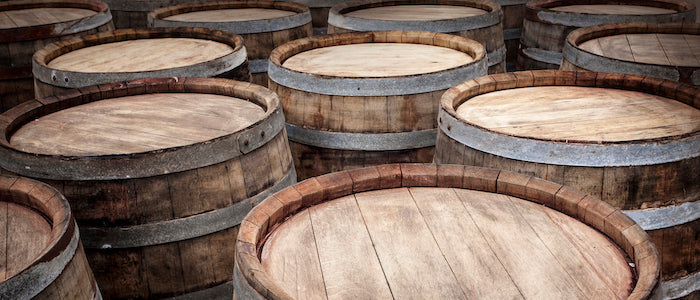So what is the difference between French oak and American oak?
For starters, French oak barrels are made from white oak trees grown in France and American oak barrels are made from white oak trees grown in the United States.
French Oak
French white oak is much tighter grained and less dense than American white oak, thus imparting more subtle flavors and firmer, but silkier tannins. It also can impart roasted subtitles and hints of spice to the finished wine.
French oak barrels are also known to provide a certain elegance and creamy quality in the wine, largely due to the silky tannins. Grape varietals such as Chardonnay tend to benefit most from aging in French oak wine barrels.
American White Oak
American white oak on the other hand tends to be looser grained and impart a stronger more prominent flavor to the wine that often resemble coconut and vanilla. Fruity new world wines benefit greatly from the rugged character American oak adds to it. One family owned company in particular has successfully championed the use of American white oak on their Cabernet Sauvignon wine, and they go by the name of Silver Oak Cellars.
Hungarian Oak
Though they might be slightly less popular, with the goal of familiarizing you with all oak styles, there is one more worth mentioning, Hungarian Oak. Hungarian Oak, sometimes referred to as Eastern European Oak, is virtually identical to the French Oak trees used to barrel age wine, with one significant difference being that the cost of Hungarian Oak barrels is considerably lower. This type of oak is most beneficial for full-bodied Malbec and Petit Verdot wines, since they have the ability to match and compliment the rich nuttiness of the Hungarian Oak. Many knowledgeable winemakers would refer to European Oak as the middle ground between French Oak and American Oak.
While there are a few different types of wine barrels out there, both American oak and French Oak wine barrels are used most frequently for barrel aging wines. Since no other properties are added into wine like they are in beer, oak aging became the acceptable way to affect the taste of wine. They contribute aromas, flavors, and tannins to a wine, but the results from different oak types are quite different. Winemakers often choose to age their wines in French or American Oak, or a combination of the two in order to get the desired flavor profiles envisioned for the finished wine.
Oak Barrel Prices
As hinted at earlier, oak barrels can get quite pricey, with French Oak barrels being the most expensive and ranging anywhere from $850 to $3600, Hungarian/Eastern European Oak barrels being the cheaper of the European options ranging from $560 to $700, and American Oak barrels being the cheapest option ranging from $360 to $500.
With the prices in mind, oak barrels are only said to add flavor to wine for two to three uses before being considered neutral. As time goes on and the demand for wine grows, you can see how this would get awfully expensive, not to mention wasteful of the oak trees since one tree typically produces merely two barrels capable of holding 50 cases of wine. So what does this mean, and what can wine makers do?
Oak Barrel Alternatives
There’s an incredible option known as Oak Barrel alternatives! So, what are oak barrel alternatives? They are oak chips, staves, and cubes that can be added to flavor the wine. This method allows for more of the oak tree to be used, is much cheaper, and less damaging to the environment. Not to mention all sides of these chips, staves, and cubes can be used, unlike an oak barrel, where only the inside can be used.
Besides the origin of the oak barrel, what are the other important factors that impact the oak influence on a wine?
The other important factors include the age of the oak, the level of the "toast", and the size of the barrel. The newer the oak barrel, the more oaky aromas and flavors will be imparted on the wine. By the fourth or fifth year of use, the flavors are negligible and the oak is termed ‘neutral’.
Barrels are usually "toasted" during its construction either in an oven or with a flame and can be given a high toast, medium toast, or light toast. The higher the toast level, the more oaky aromas and flavors will be imparted on the wine. Lastly, the size of the barrel is significant, with smaller barrels producing a greater impact on oak aromas and flavors due to the wine having more surface area in contact with the barrel.
Why are barrels the vessels of choice for the storage of wine?
The use of oak has been prevalent in winemaking for at least two millennia, first coming into widespread use during the time of the Roman Empire. Over time, winemakers discovered that beyond just storage vessels, wine kept in oak barrels took on properties that improved it by making it softer, and in some cases, better tasting.
Furthermore, the porous nature of an oak barrel allows some levels of evaporation and oxygenation to occur in wine, but typically not at levels that would spoil the wine. The evaporation allows the wine to concentrate its flavor and aroma compounds, and the small amounts of oxygen act as softening agents on the tannins of the wine.
Lastly, the different origins of oak give winemakers great flexibility in fine-tuning the flavors, aromas, color and tannins they want in the finished wine.

